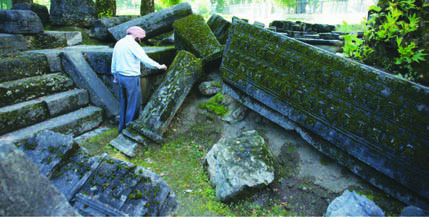
A Mw9 earthquake in Kashmir?
New data reveal megaquake is possible in western Himalayan kingdom
"We are NOT forecasting a Mw9 earthquake in Kashmir. We have merely determined that earthquakes of this severity are possible."
Despite highlighting these dire consequences, however, Bilham asserts, "We are NOT forecasting a Mw9 earthquake in Kashmir. We have merely determined that earthquakes of this severity are possible."
So why draw attention to the potential for earthquakes in this region?
Bilham believes that although currently India's building codes are adequate to protect its population, they are unevenly implemented. Advising civic leaders about the possibility of a major earthquake and enforcing building codes more strictly—especially for villages and affordable housing in cities—would mitigate more severe consequences.
Science has a duty to alert the region's inhabitants of what may occur, Bilham said. "That these megaquakes seldom occur does not mean we should ignore them," he said.

In the past several hundred years small patches of the locked region have slipped in damaging but less extreme earthquakes than the maximum possible event now identified by geodetic data, Bilham said. If a 9.0 earthquake were to occur in Kashmir, he estimates the rupture would extend from the 2005 earthquake zone near Muzafferabad, Pakistan, to the Kangra 1905 earthquake zone in northern India—a distance of about 480 kilometers (300 miles)—and from the Zanskar Range to south of the Pir Panjal range—a distance of about 190 kilometers (120 miles).
Above and near this zone, structural damage would be severe, Bilham said. Moreover, landslides may block various rivers, resulting in temporary lakes and subsequent catastrophic floods downstream outside the Kashmir Valley in the Punjab region of India, he cautions. The worst-case scenario would be a repeat of the 883 AD flood, which blocked the Jhelum River Gorge, resulting in the creation of a 15-meter-deep lake that flooded most of the Kashmir Valley. The flood alone would displace more than a million people and result in catastrophic interruption to food production, he said.
The death toll, both directly from the earthquake casualties and indirectly through flooding and food shortages, could be unprecedented, Bilham said. About 6 million people would be affected due to the collapse of buildings and civic structures, he estimated.
By Jane Palmer and Kristin Bjornsen
While the 2005 7.6 Kashmir earthquake caused 75,000 deaths and immeasurable damage to the lives of survivors, its devastating impacts could be a pale shadow of what is to come, cautions CIRES Fellow Roger Bilham.
"A magnitude 9.0 earthquake, though unexpected, is possible in Kashmir," said Bilham, whose team of CIRES scientists, along with researchers from India and Pakistan, have studied rates of crustal deformation—telltale measurements of earthquake susceptibility—in the region for the past eight years.
The study's results constitute the first comprehensive predictions of seismic activity in the area based on GPS measurements, and the collected data identify an area between the Kashmir Valley and the Pir Panjal Range where accumulating strain could potentially generate a megaquake.
This region, which is in the western end of the Himalaya in northern India and eastern Pakistan, lies along a collisional tectonic boundary, where the Indian continental plate is smashing into the Eurasian plate, thrusting up the Himalaya. By measuring how fast points in the mountain ranges to the northeast and southeast of the Kashmir Valley are converging, the researchers identified the "locked" region of the Kashmir Himalaya, north of which the rocks are being compressed. As the strain builds, the rocks will eventually reach a breaking point and allow the Himalaya to slide over the Indian plate.


